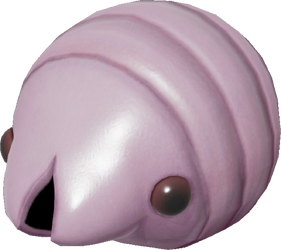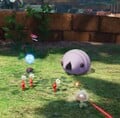Mama Sheargrub
| |||
|---|---|---|---|

| |||
| Appears in | Pikmin 4 | ||
| Scientific name | Himeagea mandibulosa (neotenic) | ||
| Family | Mandiblard | ||
| Areas | Sun-Speckled Terrace (Olimar's Shipwreck Tale), Giant's Hearth | ||
| Caves | The Mud Pit | ||
| Dandori Challenge stages | Trial of the Sage Leaf | ||
| Dandori Battle stages | None | ||
| Attacks | Crushes Pikmin | ||
The Mama Sheargrub (マザーウジンコ?, lit.: "Mother Tiny Maggot") is an large enemy found in Pikmin 4. It resembles an enlarged Female Sheargrub, but is much deadlier due to its crushing attacks and despite its size it still retains its burrowing capabilities.
Stats
| Weight | Max. carriers |
Seeds | Value | Health |
|---|---|---|---|---|
| 10 | 20 | 10 | 1000 |
Behavior
If a player, Oatchi, or a Pikmin comes nearby the summoning area, it will dig out of the ground and roam around for a bit, generally behaving like a Female Sheargrub. Should any of those three get too close or attack, it will flail and try and flatten anything that is beneath it. Once any threat has been neutralized it will return back into the earth.
Locations
- Giant's Hearth
- The Mud Pit
- Sun-Speckled Terrace (Olimar's Shipwreck Tale)
- Trial of the Sage Leaf 9th Story: Turf Turmoil
Strategy
|
The following article or section contains guides. |
The Mama Sheargrub seems unassuming, but can decimate large parts of your squad if not dealt with carefully. It is advised to avoid charging this foe with crush-weak Pikmin as there is a chance it could pre-emptively jump and crush those sent towards it. Instead, it is best to throw Pikmin (Preferably high-damaging Pikmin such as Red Pikmin) repeatedly, whistling back Pikmin thrown off to avoid them being crushed. Purple Pikmin are effective against this foe too, but beware, the fact they stop in mid-air to perform their slam attack means it is not always likely they will latch on. Since the ground it spawns from is always soft, you can use Rock Pikmin to avoid your army getting flattened and only have your Rock Pikmin be temporarily grounded, the Rock Pikmin are extra effective at charging the enemy, 25 Rock Pikmin are enough to defeat this enemy immediately with no casualties. Winged Pikmin are highly unlikely to be crushed by this foe as well, since they always try to be airborne, so using them is comparatively as safe, especially when fought in mud and mold like in The Mud Pit.
Notes
Dalmo's notes
Olimar's notes
“The Mama Sheargrub will typically molt when it reaches maturity, then dig itself into the ground to prepare for egg laying. However, certain types, like this specimen, exhibit neoteny and retain the appearance of a juvenile of the species.
If this species locates an abundant food source, they won't leave it. Sometimes they will stay at that spot for years, steadily growing to gigantic proportions, like this one.
Though this specimen has the look of a juvenile, it has fully developed reproductive abilities and can achieve impressively high birth rates. Its offspring, however, are the same size as a typical Sheargrub.”Louie's notes
Pikmin Garden
Text
“ヒラバヒメアギトのメスが幼形成熟したもので、幼体の姿のまま体が大きくなっている。サナギにはならず産卵後も生き続けるが、卵からは通常サイズのウジンコが生まれる。
特徴 その1 通常個体との違い
- 通常個体は寿命が単年だが、数年かけて10倍以上に成長する。
- (Image text: サナギにはならず体内で卵を育て、一度に100匹近くの子を産み落とす)
特徴 その2 踏みつぶす
- 大きくなってもアゴはやわらかいため、その巨体を活かした狩りを行う。
- (Image text: 獲物を踏みつぶしてから)”
Translation
“This Sheargrub female is neotenic, meaning that its body has grown in size while retaining the appearance of a juvenile. It does not become a pupa, instead continuing to live after laying eggs, but the Sheargrubs that emerge from the eggs are of normal size.
Feature #1: Differences from ordinary specimens
- The lifespan of a normal individual is a single year, but it takes several years to grow to more than 10 times the size of a normal individual.
- (Image text: "Instead of becoming a pupa, it nurtures its eggs inside its body and gives birth to nearly 100 offspring at a time")
Feature #2: Squashing
- Even after growing large, its jaws are still soft, so it hunts by taking advantage of its huge body.
- (Image text: "It feeds on its prey after squashing it")”
Other information
- Pikmin 4 Piklopedia number: #29
Naming
- Common name: Mama Sheargrub. "Mama" refers to the maturity and gender of the sheargrub.
- Japanese nickname: マザーウジンコ?. It directly translates into "Mother Tiny Maggot".
- Japanese name: ヒラバヒメアギト 幼形成熟?, lit.: "Flat Edge Small Jaw (neotenic)". ヒラバヒメアギト is the Japanese name for the Female Sheargrub, with the added clarification of its neoteny, where adults retain juvenile features.
- Scientific name: Himeagea mandibulosa (neotenic). Himeagea mandibulosa is the scientific name for the Female Sheargrub, with the added clarification that it's a neotenic form of the enemy.
- Internal names:
BIGUJINKO.UJINKOis the first part of the internal names for the Female Sheargrubs, with "big" added to distinguish the size. - Prerelease: None.
Names in other languages
|
The following article or section needs help from someone who can translate Chinese text. |
| Language | Name | Meaning | Notes |
|---|---|---|---|
| マザーウジンコ? Mazā Ujinko |
Mother Tiny Maggot | ウジンコ? is Japanese for the Male and Female Sheargrubs | |
(traditional) |
母體蛆蛆仔 Mǔtǐ Qūqū Zǐ |
||
(simplified) |
母体蛆蛆仔 Mǔtǐ Qūqū Zǐ |
||
| Koninginschaargruppie | Queen sheargrub | ||
| Boufpon matrone | Matron bridge-eater | "Boufpon" is a portmanteau of "bouffe" (eat, grub) and "pont" (bridge) | |
| Termitentos-Königin | Termitentos Queen | "Termitentos" is a corruption of "Termite" | |
| Tarlo molare madre | Mother molar woodworm | "Tarlo" means "woodworm" "Molare" may come from the molar teeth, in reference to how they "chew" bridges | |
| 엄마땅벼룩 Eomma-Ttang-Byeoruk |
Mom Ground Flea | ||
| Cupim-lacera rainha | Queen shred termite | ||
| Comején madre | Mother termite |
Gallery
A Mama Sheargrub in the Piklopedia.
A Mama Sheargrub in the Sun-Speckled Terrace in Olimar's Shipwreck Tale.
Both the corpse of a Mama Sheargrub and a Female Sheargrub for a comparison of the size of a Mama Sheargrub.
A Mama Sheargrub in front of the Yellow Onion.
Two Mama Sheargrubs in front of a hanging Slapstick Crescent in Giant's Hearth.
A Mama Sheargrub burrowing into the ground in The Mud Pit.








